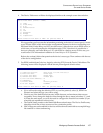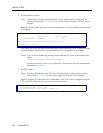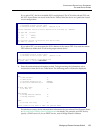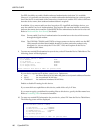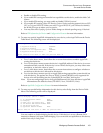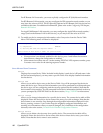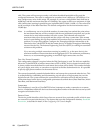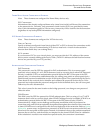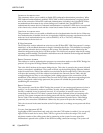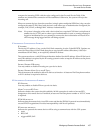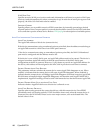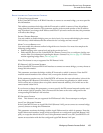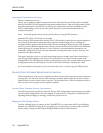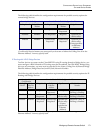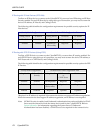
Workgroup Remote Access Switch 165
C
ONFIGURING
D
EVICE
L
EVEL
D
ATABASES
On-node Device Entries
FRAME RELAY ACCESS CONFIGURATION ELEMENTS
Note: These elements are configured for Frame Relay devices only.
PVC C
ONFIGURED
Information of the already configured frame relay virtual circuit which will be used for connections
to the remote device. Currently, only permanent virtual circuits (PVCs) are provided by frame
relay. If this information appears in a device entry, frame relay will be used first for the connection
(regardless of any backup ISDN information configured).
X.25 A
CCESS CONFIGURATION ELEMENTS
Note: These elements are configured for X.25 devices only.
V
IRTUAL CIRCUITS
Specify an already-configured virtual circuit (either PVC or SVC) to be used for connections to this
remote device. (Any two communicating X.25 devices must have a virtual circuit association
between them before they can exchange data.)
X.121
ADDRESS
If you choose an SVC for your virtual circuit, you must provide the X.121 address of the remote
device you are currently adding to the Device Table. (The X.121 addresses for both local and remote
devices are provided by your X.25 provider.)
A
UTHENTICATION CONFIGURATION ELEMENTS
PAP PASSWORD
This password is used by PPP line protocol for PAP authentication. This is an unencrypted
password value (a string of 1 to 12 ASCII characters) used as a security check when PAP Password
Security is enabled. (PAP is an authentication protocol defined in RFC 1334 as part of the PPP
protocol suite.) At connection establishment time, the calling party sends an unencrypted device
identifier and password combination over the WAN to the system. The system looks up the Device
Name based on the received device identifier and validates the password for that device. If the
password received matches the password configured for the identified device, the call is accepted.
Otherwise, the call is disconnected.
This value is stored in the same location as the bridge password, so a change to one password
affects the other.
CHAP S
ECRET
This field is used by PPP line protocol for CHAP authentication. This is a string of 1 to 17 ASCII
characters that is used as a security check when CHAP Challenge Security is enabled. (CHAP is an
authentication protocol defined in RFC 1334 as part of the PPP protocol suite.) CHAP is
characterized by a highly secure challenge and response mechanism which is performed at
connection setup, and which can optionally be repeated throughout the existence of the connection.
A shared CHAP Secret is configured for the devices at both ends of the connection. Refer to System
Information, system secret. As opposed to a password, a CHAP Secret is not sent across the link, and
therefore is not susceptible to interception. Instead, a calculation is done on the packets transmitted
between the two devices, and the results are compared to the shared CHAP Secret for validation.
If the calculation’s results do not match the expected results, the connection is terminated.



